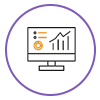4 simple steps for
migrating to
MariaDB with zero coding


Create connections
between data
sources and MariaDB


Prepare a source to the MariaDB pipeline by selecting tables in bulk


Assemble a workflow and schedule it to start the MariaDB migration process

Share your data
with third-party platforms
over API Hub

Simple and Intuitive
Switch to MariaDB like a boss

High-Speed Performance
Enjoy MariaDB's high-speed performance with codeless data environment

Prebuilt Transformation
Say goodbye to tedious manual tasks with prebuilt transformation templates

Monitoring Data
Monitor your MariaDB data frequently

Integrate data from ERP, CRM, legacy databases, and other 300+ sources to MariaDB
Hear how Lyftrondata helped accelerate the data
journey of MOL Group
reporting
onboarded
reduction
sales
 Lyftrondata enables instant analytics on WNI weather data that helped us streamline shipping lines.
Lyftrondata enables instant analytics on WNI weather data that helped us streamline shipping lines. 

Koichi Tsuji
Consulting Partner at MOL Group
FAQs
What is MariaDB?
MariaDB Integration is a community-developed, commercially supported fork of the MySQL relational database management system, intended to remain free and open-source software under the GNU General Public License.
What are the features of MariaDB?
InnoDB: MariaDB Integration is a general purpose storage engine known for balancing high reliability and high performance.
XtraDB: Once a more popular choice than InnoDB, XtraDB was designed as a drop-in storage engine for MariaDB ETL.
Galera Cluster: MariaDB Drivers offers Galera Cluster service.
Sequence Storage Engine: MariaDB Connectors tool offers Sequence Storage Engine.
What are Lyftrondata- MariaDB connectors?
MariaDB Connectors tools are not fully compatible with MySQL.
Unstable cluster version of MariaDB ETL
Few MySQL Enterprise Edition features are not present in MariaDB Drivers tool.
Start modernizing your MariaDB journey today
